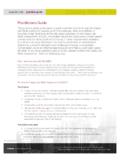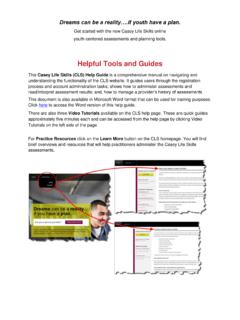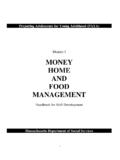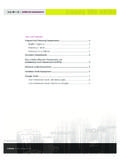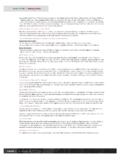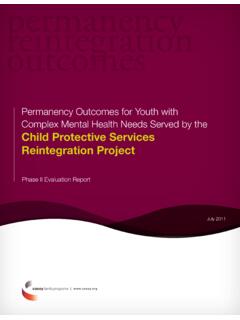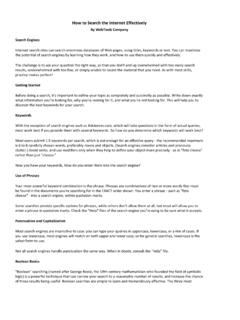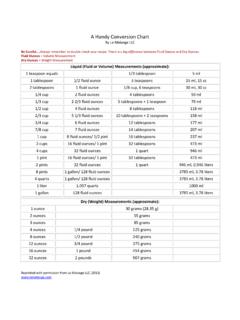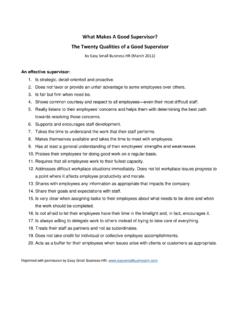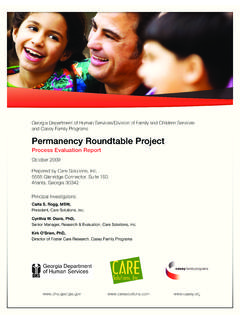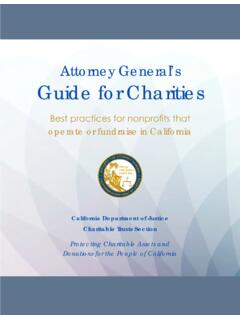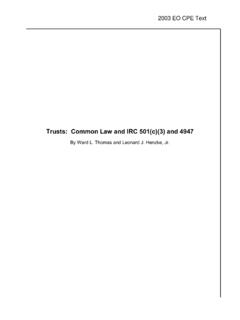Transcription of Ready, Set, Fly! A Parent’s Guide To Teaching Life Skills
1 Ready, Set, Fly!A Parent s Guide To Teaching life SkillsTucson Division1600 North Country Club RoadTucson, AZ 2001. Casey Family Programs. Seattle WA. All rights OverviewCasey Family ProgramsFoundations for the FutureThe mission of Casey Family Programs is to support families, youth, and children in reaching their full provides an array of permanency planning, prevention, and transition services such as long-term family fostercare, adoption, kinship care, job training, and scholarships. Through advocacy efforts, national and local communitypartnerships, and by serving as a center for information and learning about children in need of permanent familyconnections, the Programs aim to improve public and private services for children, youth, and families affected bythe child welfare Family Programs is a Seattle-based private operating foundation, established by JimCasey, founder of United Parcel Service (UPS), in 1966.
2 The program has 29 offices in 14 statesand Washington, For more information, visit our web site at of TrusteesRichard D. Ford, PresidentJoan B. Poliak, Vice PresidentDuncan A. Bayne, SecretaryRichard E. Bangert, TreasurerPatricia Batiste-Brown, TrusteeGary Severson, TrusteeJohn C. Peterson, MD, TrusteeEarl L. Buckley, trustee EmeritusGeorge E. Fahey, trustee EmeritusJohn N. Riese, Esquire, trustee EmeritusChief Executive OfficerRuth W. MassingaExecutive Vice President of Strategyand Program DevelopmentJean McIntoshExecutive Vice President of RegionalOperationsJames MarquartAcknowledgementsReady, Set, Fly!
3 Was developed through the efforts of many dedicated child and family servicestaff members, foster parents , and youth. The Tucson division s Self-Sufficiency team dreamedof this project, championing it to fruition. They include Susan Bergesen, Sharon Dobbin,Maureen Andrew and Gloria Verdin. In addition, Ami Nagle, an independent contractor with theTucson division was instrumental in conducting the focus groups and writing the Kehl, an independent contractor, was the project coordinator and assisted with writingand editing, and Melissa Sabol and T. Kay Estes, social work interns, provided clerical Services also supported this endeavor by transcribing focus group tapes, generalediting assistance and coordinating the print and online design work.
4 They include Kimberly , Margaret Jeffrey, A. Chris Downs, and Richard Bressani. We also thank Dorothy Anselland Joan Morse for their feedback on the activities and the focus group gratefully acknowledge the assistance of the following dedicated foster parents and youthwho faithfully attended at least one focus group, sharing their knowledge and ideas about how toprepare youth for living on their own. They include: Angela Adkins, Patti Adkins-Tutty, RonAlegria, Dawn Alegria, Marie Cephers, Ray Christian, Shirley Christian, Melissa Croft,Ready, Set, Fly! A Parent s Guide To Teaching life Skills 2001 Casey Family DiCicco, Alex Enoch, Pat Espinosa, Albert Garcia, Gloria Garcia, Mary E.
5 Stafford,Beth Harper, Pam Ketterling, Mary Killary, Eileen Loughrey, Jeffrey Macbeth, BarbaraMartinez, Carlos Martinez, Mildred A. McClain, David McDonald, Lillie Murray, EvangelinaNavarrette, N. Lejana Olague, Juanita Pennington, Jesus E. Perez, Charlotte Perez, BarbaraReyes, James O. Reyes, Pearl Taylor, Reggie Taylor, Vivica Taylor, Lucia Tempe, WilliamThomas, Robert Villelas, Terry Villelas, and Carol also acknowledge Tucson Division staff members who provided valuable ideas and supportfor this project. They include Susan Abagnale, Ana Acuna, Leslie Butler, Jorge Cabrera, AmyCox, Dixie Ellis, Levonne Gaddy, Joan Hansman, Fredericka Hunter, Cindy Johnson, MarjorieParks, Yvonne Rodriguez, Rosalyn Riesgo, Leora Sanders, Laura Stockert, Ward Townsend,Beth Treas, Bobbie McNeill, Bea Kea, and Patricia of Contents1.
6 Introduction2. How to Use3. Daily Living Skills4. Housing, Transportation & Community Resources5. Money Management6. Self-Care7. Social Development8. Work & Study Skills9. Ms. Quince A os: A Story of life Skills in ActionReady, Set, Fly! A Parent s Guide To Teaching life Skills 2001 Casey Family IntroductionReady, Set, Fly! A Parent s Guide to Teaching life Skills was created through a series ofdiscussion groups with foster and adoptive parents , teens, and young adults at the TucsonDivision of Casey Family Programs. The goal was to develop a practical resource to helpcaregivers teach youth some of the Skills that are needed to enable youth to live successfully ontheir own.
7 The skill areas described in the life Skills Guidebook ( ) wereused to Guide discussions and form the foundation of this activity book. Ready, Set, Fly! is acompanion tool for the life Skills Guidebook (Guidebook) and contains activities for use in one-on-one settings. It was created primarily with foster parents in mind. However, the activities areuseful for all parents as they teach life Skills to children and youth. Child welfare professionalsmay use this book to provide suggestions to caregivers about Teaching life Skills to their activities are age appropriate and developmental, matching the levels of the Ansell-CaseyLife Skills Assessment ( ) and Guidebook (ages 8-10, 11-14, 15-18, and19 and older).
8 DescriptionThe Tucson division created Ready, Set, Fly! for several reasons. First, staff needed a resourcethat would help them work more easily with families and youth to teach life Skills . While parentshad resources that described what Skills youth should be building, they lacked concrete activitieswhich would help them teach these Skills in their own homes. Second, the Tucson staff alsowanted a Guide to help parents become aware of the teachable moments in everyday life thatprovide opportunities for Teaching Skills . To meet these needs, a fun, user-friendly instructionbook containing developmentally arranged activities was create Ready, Set, Fly!
9 , foster and adoptive parents met in discussion groups to discuss the sixlife skill areas in the life Skills Guidebook (daily living Skills , housing, transportation andcommunity resources, money management, self-care, social development, and work and studyskills). During the discussion groups, creative and effective ideas of how parents taught andyouth learned life Skills in one-on-one situations were brainstormed. These ideas were thenReady, Set, Fly! A Parent s Guide To Teaching life Skills 2001 Casey Family into an easy-to-use format for other parents to use in Teaching life Skills .
10 Theseactivities vary from simple to more complex and can be used with children whose ages rangefrom elementary to post high How to Use Ready, Set, Fly!The activities in this book are organized into six areas, or domains, that match the sections of theAnsell-Casey life Skills Assessment (ACLSA) and life Skills Guidebook. parents and youthcan easily select the level of each activity, according to the youth s age, that will be most helpfulto the youth s life skill growth. The difficulty of each activity is rated using the following scale:Level 1 is for youth ages 8-10 yearsLevel 2 is for youth ages 11-14 yearsLevel 3 is for youth ages 15-18 yearsLevel 4 is for youth ages 19 and olderReady, Set, Fly!
